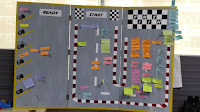
User Story: As a new participant in an Agile world, I need to
understand why I need a physical task board so I can make best use of it and
not feel like I'm wasting my time.
Acceptance Criteria: Teams embrace the
task board and begin to experience the results that occur with synergy.
In Agile we can use many different tools
to help us track the work we're doing and provide our stakeholders with
information. Many of these tools include a digital task board; this can be
useful for teams, especially if they have remote team members or are a
distributed team.
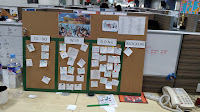 However, I coach teams to maintain a
physical task board for several reasons. They can be a great information
radiator for everyone interested in whatever you are doing--external
stakeholders, other teams, managers, etc.
However, I coach teams to maintain a
physical task board for several reasons. They can be a great information
radiator for everyone interested in whatever you are doing--external
stakeholders, other teams, managers, etc.
A physical task board is also a good place
to hold the daily stand up; gathering around this helps keep everyone focused
on what we're talking about and makes very visible the progress against the
commitment, or lack of.
But the main reason I coach to physical task
board is because of what I call the magic.
It's not really magic, but there is an effect that occurs for those teams that
really embrace the task board and the benefits are many.
Generally, when I mention that having a
physical task board--and holding stand up there every day--is a good idea and
one I highly recommend, I get the questions. "Do we have to have a task board; is it required?" "Why do we
need that and the one in the tool?" “Isn't that duplication of
effort?" “Do we have to hold stand up every day?"
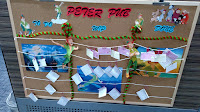 I always answer the same, “It’s up to each team to decide whether
to have a physical task board. It is not a requirement and yes, it may feel
like duplication of effort, but the synergy your team will realize as a result
of that simple board will astound you. Try it for a sprint or two and if you don’t
feel you derive any value from it, stop doing it. Oh and yes, you really should
hold stand up every day.”
I always answer the same, “It’s up to each team to decide whether
to have a physical task board. It is not a requirement and yes, it may feel
like duplication of effort, but the synergy your team will realize as a result
of that simple board will astound you. Try it for a sprint or two and if you don’t
feel you derive any value from it, stop doing it. Oh and yes, you really should
hold stand up every day.”
That’s usually enough for most teams to choose to try it; we can
try anything for a couple weeks, right?
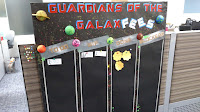 Some team members feel self-conscious and even embarrassed by
setting up a task board. Writing their tasks on colored post-its and posting them
in a publicly visual space and then standing there in front of it each day. This
is so different from what we’re used to; even if our work is in some tool
somewhere it’s not visible like this, where everyone can walk by and see or
hear us talking about it.
Some team members feel self-conscious and even embarrassed by
setting up a task board. Writing their tasks on colored post-its and posting them
in a publicly visual space and then standing there in front of it each day. This
is so different from what we’re used to; even if our work is in some tool
somewhere it’s not visible like this, where everyone can walk by and see or
hear us talking about it.
But that is when the magic begins.
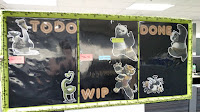 Some teams do the bare minimum and their boards may be monotone
with the fewest columns and frills. Some teams really enjoy setting up their
task board and making it their own in very creative ways. I encourage them to
pick a theme or find a way to relate it to their team name, whatever matters to
them as a team and is something they will maintain.
Some teams do the bare minimum and their boards may be monotone
with the fewest columns and frills. Some teams really enjoy setting up their
task board and making it their own in very creative ways. I encourage them to
pick a theme or find a way to relate it to their team name, whatever matters to
them as a team and is something they will maintain.
Then they plan some work, add it to the board, and start meeting
every day for stand up. Their update to one another is accompanied by moving
the tasks across the board and they begin to hold one another and themselves
accountable to the commitment they made at planning.
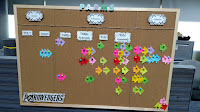 As time goes by, and sprint after sprint is completed, team
members begin to nudge each other to join stand up, they will relay their
update to someone else on the team if they can’t make it, possibly email it if
they know they won’t be there but the team needs the information.
As time goes by, and sprint after sprint is completed, team
members begin to nudge each other to join stand up, they will relay their
update to someone else on the team if they can’t make it, possibly email it if
they know they won’t be there but the team needs the information.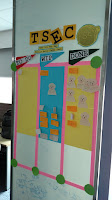 They celebrate when tough tasks make it into the Done column, they
swarm on tasks that threaten their commitment, and they work together to figure
out how to divide up tasks when someone can’t meet their commitment for
whatever reason. They begin to focus on the work, not who might be looking at
them.
They celebrate when tough tasks make it into the Done column, they
swarm on tasks that threaten their commitment, and they work together to figure
out how to divide up tasks when someone can’t meet their commitment for
whatever reason. They begin to focus on the work, not who might be looking at
them.
They stop seeing the color of the post its and the cartoon images
on the board and see the work represented and how it progresses across the
board; and in fact, want to show off their board and explain what they’re doing
and that they figured out how to do something faster or more efficiently or
with better quality.
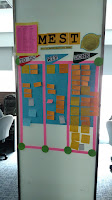 Eventually, they become a cohesive team and OWN the task board
they initially felt was unnecessary and a duplication of effort.
Eventually, they become a cohesive team and OWN the task board
they initially felt was unnecessary and a duplication of effort.Synergy is defined as, the interaction of elements that when combined produce a total effect that is great then the sum of the individual elements. A basic condition for synergy is that the key players must effectively interact with each other.
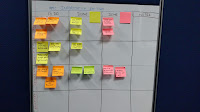 Patrick Lencioni's book, the The Five Dysfunctions of a Team covers many of the issues that task boards address: "1) the absence of trust and openness among teams members; 2) fear of conflict; 3) lack of commitment to a topic or plan; 4) unwillingness to hold teammates accountable; 5) and inattention to results and lack of focus on the collective actions that must be taken." Task boards require that teams work through these things to optimal resolution and all in public.
Patrick Lencioni's book, the The Five Dysfunctions of a Team covers many of the issues that task boards address: "1) the absence of trust and openness among teams members; 2) fear of conflict; 3) lack of commitment to a topic or plan; 4) unwillingness to hold teammates accountable; 5) and inattention to results and lack of focus on the collective actions that must be taken." Task boards require that teams work through these things to optimal resolution and all in public.
Daniel Pink tells us
that what really motivates people are autonomy, mastery, and purpose. The autonomy
and purpose afforded by task boards lead to mastery of the skill sets, and/or
the work we’re doing that is depicted on that board.
There are many and varied reasons tasks boards work so well.


No comments:
Post a Comment